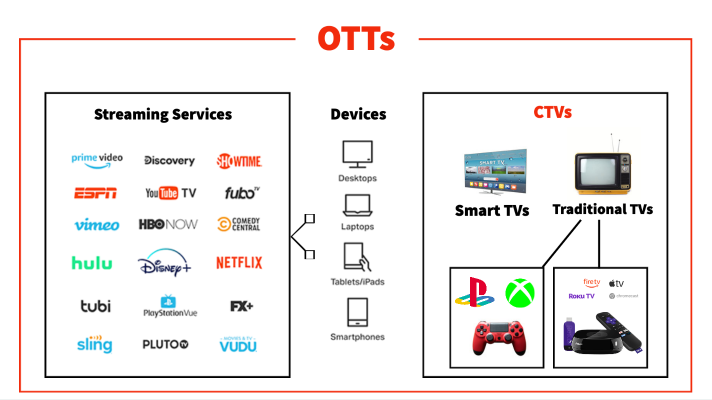Connected TV (CTV) is a type of television that is connected to the internet, allowing users to access streaming video content and other online services. Unlike traditional broadcast television, which is delivered over airwaves or via cable or satellite, CTV relies on an internet connection to deliver content.
CTV devices typically include smart TVs, game consoles, and streaming media players, such as Roku, Apple TV, or Amazon Fire TV. These devices can access a wide range of streaming services, including popular options like Netflix, Hulu, and Amazon Prime Video, as well as many other specialized or niche streaming platforms.

How is CTV important for advertisers and chief marketing officers?
Connected TV (CTV) has emerged as a major force in the world of television advertising, and is increasingly being seen as a critical component of any effective marketing strategy. With more and more consumers turning to streaming video services and connected devices, advertisers and chief marketing officers (CMOs) are realizing that CTV offers a unique opportunity to reach a wide and diverse audience with targeted and relevant advertising.
The rise of CTV is particularly significant because it offers a new way to reach audiences that are increasingly difficult to reach through traditional broadcast TV. As consumers have moved away from cable and satellite TV in favor of streaming video services, they have become more difficult to reach with traditional advertising methods. CTV offers a way to reach these consumers in a more targeted and relevant way.
CTV advertising vs Linear TV advertising
The biggest advantage of CTV is that CTV devices are connected to the internet, which enables advertisers to gather more data about viewers’ viewing habits and preferences than linear TV.
Pros and Cons of CTV advertising
Pros
- CTV data can be used to target ads to specific demographic groups, geographic areas, or even individual viewers. This targeted approach can be far more effective than traditional broadcast advertising (linear TV), which may not reach the desired audience.
- CTV data can measure the effectiveness of advertising with greater accuracy.
- CTV data can measure the impact of advertising campaigns in real-time and adjust strategies as needed by tracking a range of metrics, including views, clicks, and engagement rates. This level of precision and flexibility can be particularly valuable for CMOs and advertisers, who are under increasing pressure to demonstrate the effectiveness of their marketing efforts.
Cons
Despite these advantages, however, there are some challenges to CTV advertising that must be addressed.
- It can be difficult for advertisers to ensure that their ads are being seen by the right audience at the right time due to such a wide range of programming choices CTV devices offer.
- The fragmented nature of the CTV ecosystem can make it difficult to reach audiences at scale.
Nonetheless, these challenges can be overcome with effective targeting and measurement strategies.
Overall, the rise of CTV represents a major opportunity for advertisers and CMOs to reach audiences in new and innovative ways. By leveraging the power of the internet and targeting specific audiences with precision, CTV advertising can be a highly effective way to reach consumers in a fragmented media landscape. As the world of television continues to evolve, CTV is likely to become an increasingly important part of any comprehensive marketing strategy.
Sources / Suggested References: